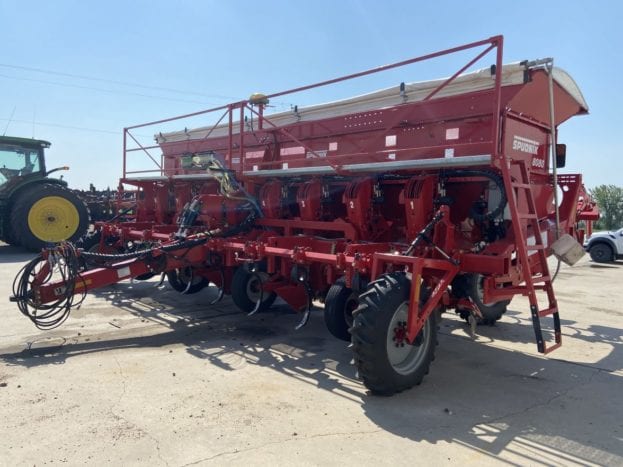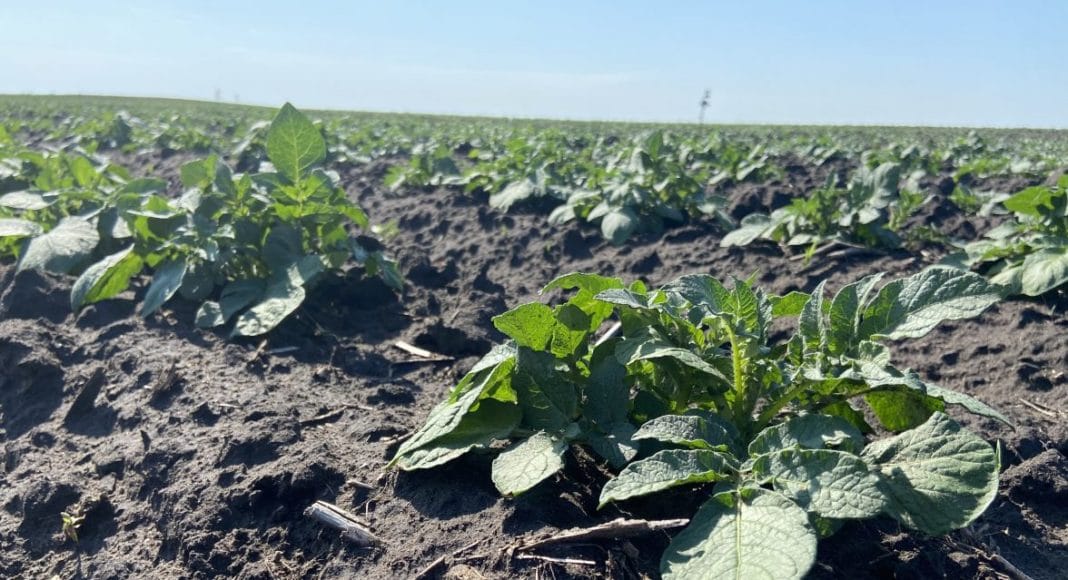A farmer in Manitoba is trying out a first of its kind seeding experiment — using direct seeding with minimal tillage to try and reduce soil compaction and erosion in his fields.
Chad Berry has been practicing zero tillage seeding on his grain crops for years but had always wanted to do it on his potato fields. However, he didn’t feel his potato planter would work for it, so when he upgraded his planters last year, he decided it was finally the time to give it a try.
“We just wanted to try and prevent erosion in the spring. We’ve always got fields that are blackened and dusty for four or five weeks every spring after planting,” Berry says in an interview on his farm, Under the Hill Farms near Cypress River, Man. “The best case (scenario is) we have a crop up in three weeks and still a lot of the time for the field will blow. It’s very erodible.”
Berry approached his local equipment dealer genAG with his idea of reducing tillage on his potato fields. They travelled to the AGRITECHNICA farm equipment show in Germany and found some inspiration from Grimme planters. Back in North America they worked with SPUDNIK to develop the SPUDNIK 8080 planter with hill shapers mounted on the back.
“The idea is you can eliminate a few passes. A lot of people deal with compaction issues and different stuff like that, which this can really help,” Mike Wall, SPUDNIK specialist with genAG, says in an interview at Under the Hill Farms.

Last year, Berry planted five acres using direct seeding with minimal tillage on rye stubble. While he was impressed with the emergence and stand of the crop, the wet, cold fall stopped him from harvesting the crop.
During the winter, the J.R. Simplot Company approached Berry about his experience. The potato processing company had heard he had been experimenting with direct seeding and were interested in finding out more.
“Sustainability, soil health and water conservation are always at the forefront of Simplot’s mind when it comes to growing high quality potato crops,” Scott Graham, agronomy raw development manager with J.R. Simplot Company, says in an interview at Under the Hill Farms. “Anything we can do to promote the long-term sustainability of the farmer’s fields while producing high-quality yields is a win for all of us and we felt like Chad’s efforts in direct seeding last year showed enough promise that it would be good to follow into 2020.”
Last fall Berry ripped a canola field with an eco-till sub-soiler with 1 ¼ inch shanks at a depth of 15 inches. In the spring he seeded 70 acres of the field with direct seeding, the fertilizer was broadcast on top and then the planter ran directly into it. The rest of the field was planted traditionally in order to allow for a comparison.
Simplot and Vikram Bisht with Manitoba Agriculture have been monitoring the field. They have been testing soil compaction between the two sides of it. They’ve also been measuring hill dimensions.
“We’re thinking there possibly could be more soil left available on the hill tops and sides of the direct seeding side,” Graham says. “Just because there’s more stubble, straw and residue that may hold that soil on a windy day.”
There was a slight difference in emergence with the traditionally planted side coming up a day or two ahead of the direct seeding area. Berry suspects if he would have watered the field directly after seeding, the plants would have emerged at the same time.
This trial is a first of its kind and has been drawing attention from across North America. Simplot hosted a field day at Under the Hill Farms on June 17 to show other growers what Berry has been doing.
“I know we’ve got a lot of people across North America that are talking about this,” Wall says. “Amongst the SPUDNIK dealer group, they all want to keep updated on how this works. This could change some stuff if it does work.”
Results will be being released after Berry harvests the crop this year.











